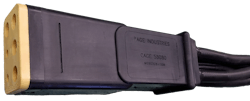Hard-Headed Power
Any aircraft that has the capability of using external ground power to supply its electrical loads needs a reliable ground power cable. PAGE GSE’s 28V DC and 400 Hz power banded cables were designed to safely carry electrical power from a fixed or mobile power supply to an aircraft.
“This power needs to match the same critical performance specifications the onboard generators produce in flight,” says Brian Piety, president of PAGE GSE. “When the power is provided externally to the aircraft, it must be safe and efficient. By providing ground power to the aircraft while it is on the ground, it allows the aircraft to turn off its APU, providing the operator with a more efficient, less costly solution.”
Piety also notes using ground power is more environmentally friendly than running an APU.
The 28V DC and 400 Hz power banded cables differ from others on the market because of PAGE GSE’s Hardhead technology — a feature designed to better protect the cable’s electrical components.
While other power cable assemblies may use a screw-on plastic cover over the electrical contacts, PAGE’s Hardhead tip is molded into the connector. This protects against liquids entering the electrical components, which could lead to corrosion and electrical shorting.
“We utilize our Hardhead tip molded into the end of the aircraft connector where the vast majority of the wear takes place. This is the first item that wears out on a standard cable assembly and is the key reason older cable assemblies have to be replaced,” he explains.
“Only PAGE integrates the hard tip into the connector without the need for screws,” Piety continues. “PAGE also has a proprietary compound that enables our tip to last much longer. Additionally, the PAGE assemblies come with thermal protection in the connector body.”
This thermal protection kicks in if the cable reaches 110 degrees Celsius, automatically switching off the power.
“In case there’s a bad connection — which can be caused by various things — heat would build up in that area. So, we have a thermal switch in there that will trigger the electrical ENS circuit to break and that stops the power before damaging the aircraft or possibly injuring a person,” Piety says.
In addition to these safety features, the cable is also ergonomically designed for ease of use.
“We spent the time to update these connectors, which for the most part have not changed in technology or appearance for perhaps 30 years, by incorporating locations on the connector body that were designed to place your hand to achieve a better grip to make it easier to engage and disengage the connector from the aircraft,” he notes.
PAGE GSE has been manufacturing 400 Hz single jacketed cable assemblies for eight years, but only last year did the company enter the banded cable market.
According to Piety, banded cables are mostly used on mobile pieces of equipment whereas the single jacketed cables are used primarily on bridge-mounted and hangar 400 Hz set-ups. The banded cables are more flexible and fit in the trays on mobile equipment easier than the single jacketed cables.
Piety says PAGE GSE patiently waited to enter the banded cable market until the company had a product that could compete well with others. He mentions before entering a certain market, it is important to pay attention to it, listen and respond to customer requests, then bring products to the market that differ from what is currently available, which is why the 28V DC and 400Hz power banded cables have military certification.
“We took our knowledge of cable assemblies and challenged ourselves to build the best one possible,” he continues. “By coming in recently, it allowed us to start with a clean slate and design the best connector possible inside and out.”
The cables did not have to meet military standards to enter the market, but Piety says they sought military approval to differentiate its power banded cables from others.
He notes the cables went through certain testing to achieve this certification. These tests take into account the type of materials used in the cable and what stranding is used, among other items.
The 28V DC and 400 Hz cables are also built to SAE (AS5756) standards. SAE standards are set by industry experts to ensure end-users receive a safe, quality component that is built to a high standard, according to Piety.
“These tests include a vast array of parameters from hot and cold temperatures, impact tests, electrical performance, chemical resistance and environmental exposure just to name a few,” he says.
PAGE GSE sells the 28V DC and 400 Hz cable assemblies to airports, airlines, ground handlers, FBOs, OEMs and the military all around the world. These operators choose between the 28V DC or 400Hz cables depending on what aircraft they fly.
“28V DC power was the original power produced by aircraft while flying to power all its electrical demands,” Piety explains. “As the electrical demands grew, the need to supply this demand while keeping the generator compact, resulted in a new power profile of 115/200VAC at high 400 cycles. Today, most large commercial aircraft operate on 400 Hz AC power. Smaller regional jets, corporate aircraft and some helicopters still use the 28V DC load profile.”
Piety says PAGE GSE’s customers are satisfied with the product and the feedback the company has received has been favorable.
“There have been no requests for even one change,” he says.
While these cables do not require any regular maintenance, Piety says operators should always visually inspect the connector on an ongoing basis to see if it has been damaged.
He notes cables may be dragged on the tarmac or even driven over by a tow tractor. He also mentions users should periodically verify the sockets within the connector have the correct grip.
“When it comes to external ground power cables,” he says, “most customers understand the environments and harsh usage these cables endure.”
